Nothing beats grilling and not having to clean up after. Except when you add bottomless side dishes, tasty stews and ice cold booze.
KBBQ is the backbone of Korean civilization. It’s more than just a meal, it’s a total experience that delights all the senses.
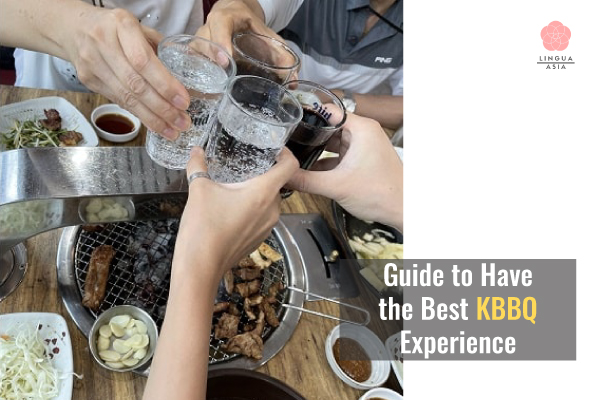
Quick Tips
- Apron up to protect your clothing.
- Use all the toys, including scissors, tongs, and wet wipes.
- Try out the dips.
- Ask to change the grill every few rounds, so you get clean, flavorful KBBQ all night.
KBBQ is huge in the U.S.A., U.K., Canada and Australia, so you’ll have no problem finding a place.
1. Pick the right place
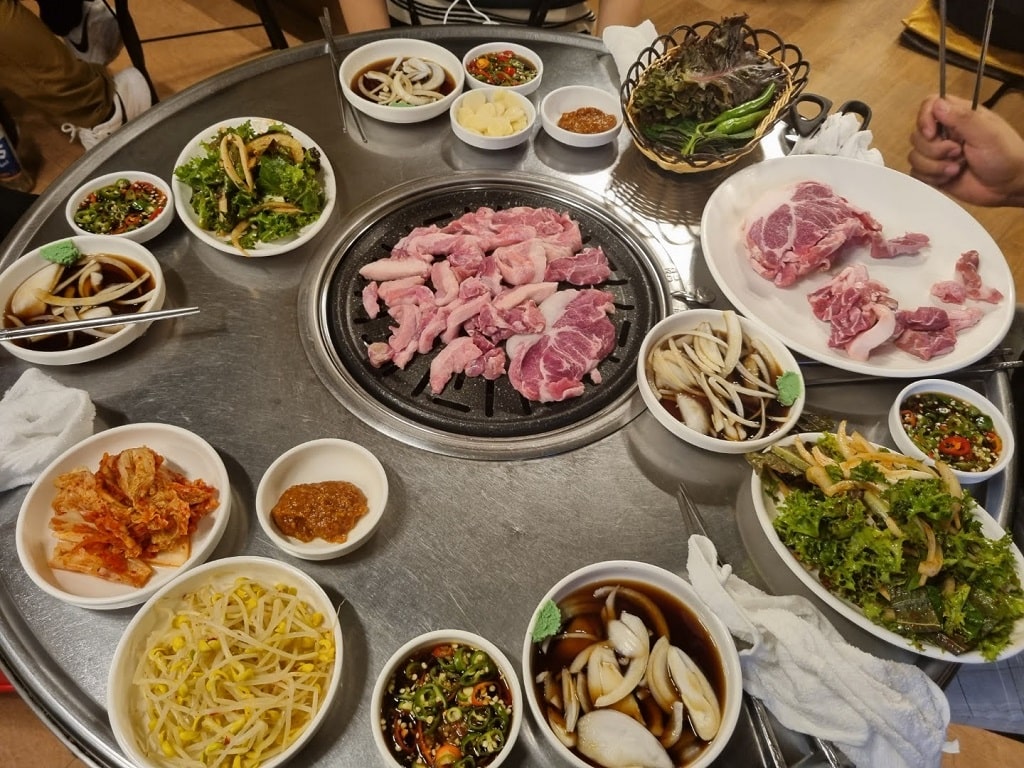
Ask yourself what you’re in the mood for. There are a few things to consider when choosing a KBBQ restaurant.
Ordering
There are two types of KBBQ restaurants:
- All-you-can-eat (AYCE or gogi buffet): It can be loads of fun grilling up as much meat as you can handle. There’s usually a time limit and it becomes a race to put heat to meat as quickly as possible. They offer great value though and you’ll get your money’s worth.
- Order as you go (gogitjib): Most places in Korea are like this because meat is more expensive. You can take your time and have a relaxing experience. It’s a bit pricier, but the quality of meat is higher. The nicer places will cook the meat for you.
Meat
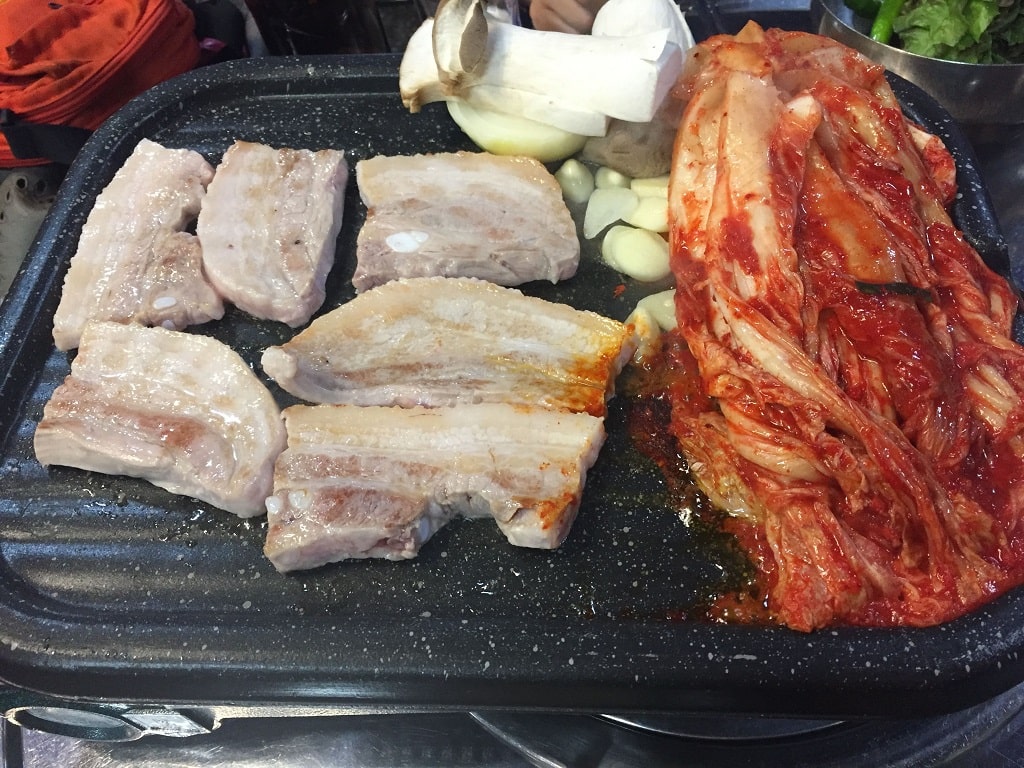
KBBQ restaurants in Korea often specialize in one type of meat and cut. For example, some mainly serve samgyeopsal (pork belly). You’d go to a specific place to get what you’re craving.
In the states, they tend to offer a variety of meats and cuts. Most places serve beef, pork, chicken and seafood in different marinades.
Heat
There’s also different types of heat sources. They each provide their own flavor and cooking time.
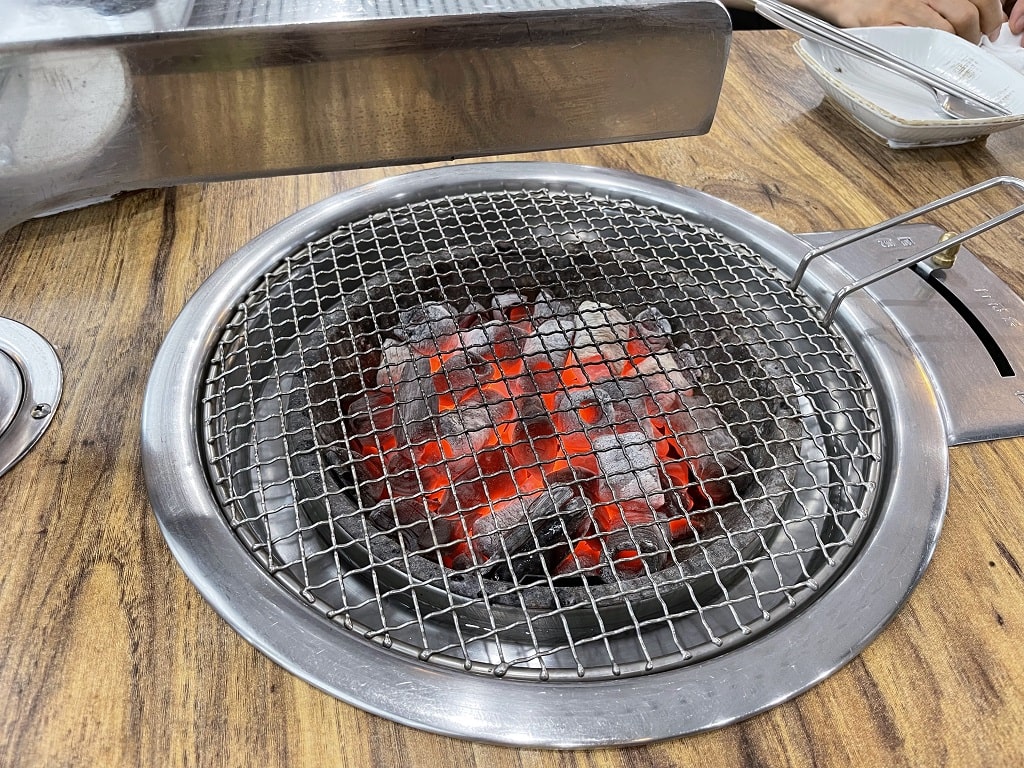
- Charcoal (sootbul): Fast cooking time and decent flavor
- Briquettes (yeontan): Relatively fast but gives off a unique flavor
- Gas: Slower cooking time and less flavor, but less smoky smell on your clothes
- Wood: Not so common at restaurants, but great for camping. It’s a bit slower than the other options but has really nice flavor
- Portable stove (buhnuh): The weakest of all that’s usually for camping or outdoor use. It’s great for bulgogi types.
2. Sit on the floor
For the full experience, I recommend the floor if it’s available. You take your shoes off and sit cross-legged on mats (it’s a great way to see who’s wearing lifts too). Fancier places will have little floor chairs with a back rest. A few have a recess in the ground where you dangle your legs. I switch between floor and chair, but there’s something intimate about sitting on the floor.
Also, don’t be shy to ask for a private room if you have a big party for the VIP experience.
3. Use all the toys
Scissors, tongs and wet wipes oh my.
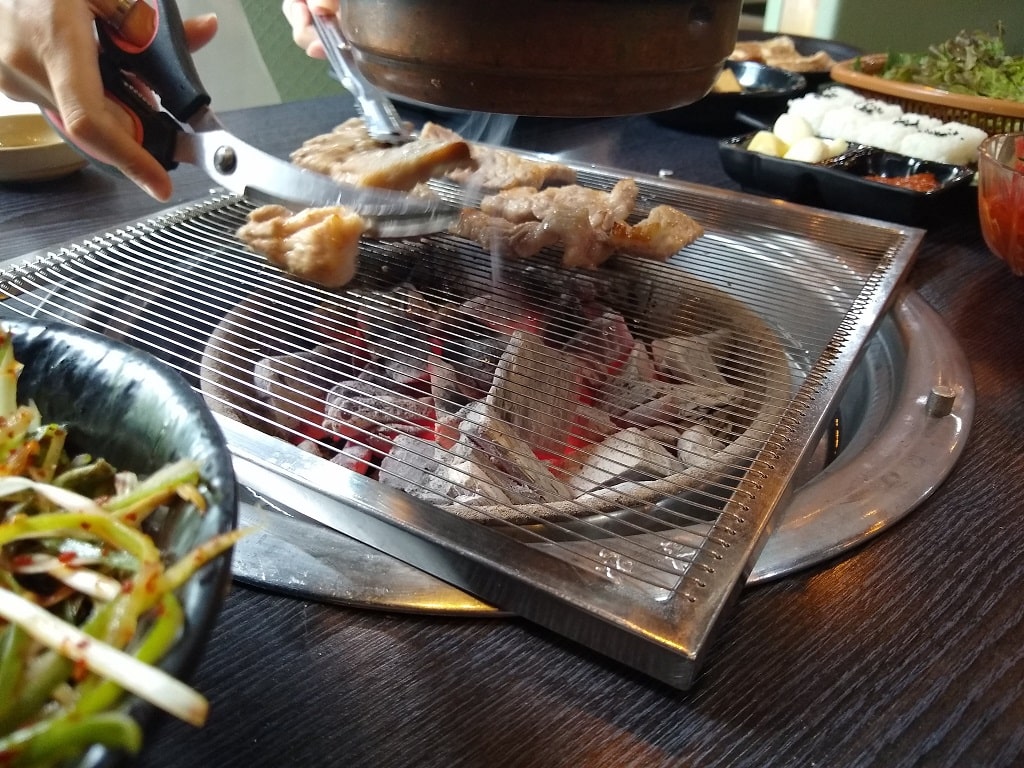
You’ll find no shortage of useful and novel accoutrements at a Korean BBQ place. Use them all for the full effect.
Some places even have drawers for utensils.
The most important items are:
- Tongs (jibgae)
Great for picking up things like uncooked meat and salad. You don’t want to use your chopsticks when handling raw meat. There are actually separate tongs for meat and salad, so make sure to ask if they don’t provide them. - Scissors (gawee)
These are magical tools that make it easy to cut things like kimchi and meat on the grill without a cutting board. Like before, there should be specific ones for each purpose. For example, there are scissors for cold noodles after the BBQ part (more on this later). - Personal plates (apjeobshi)
You can dish up things like meat and side dishes on these plates. The person cooking will drop off pieces of meat on these with their tongs so they don’t get burnt. - Little dipping bowls (sosu gurut)
Perfect for things like toasted sesame oil or samjang.
More about Korean toys
4. Apron up
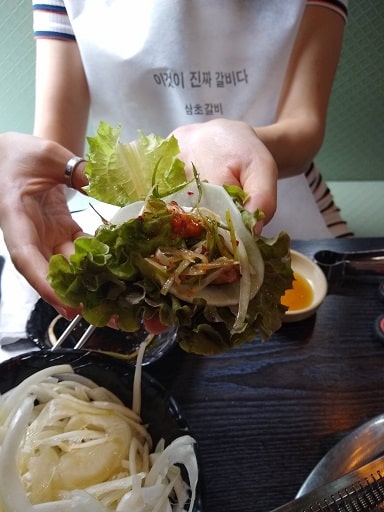
Things get lively throughout the night and you’ll be sitting in a splash zone before you know it. Use one of the adorable aprons to protect your clothing.
5. Hide your things
KBBQ places use ventilation systems but they don’t always remove all the smoke. The vents that get closest to the grill do the best job.
Some places have empty stools you can put your coat and bag in to prevent them from smelling. There’s often a bottle of Febreeze to help out at the exit. Very cool indeed.
6. Ask an ajumma
If you’re feeling overwhelmed by it all, ask for help. Whether you’re unsure of what to order and which drink to pair it with, or you don’t know when the meat is done, the staff will be eager to assist. Push the nifty call bell for the best results.
7. Pick the meat
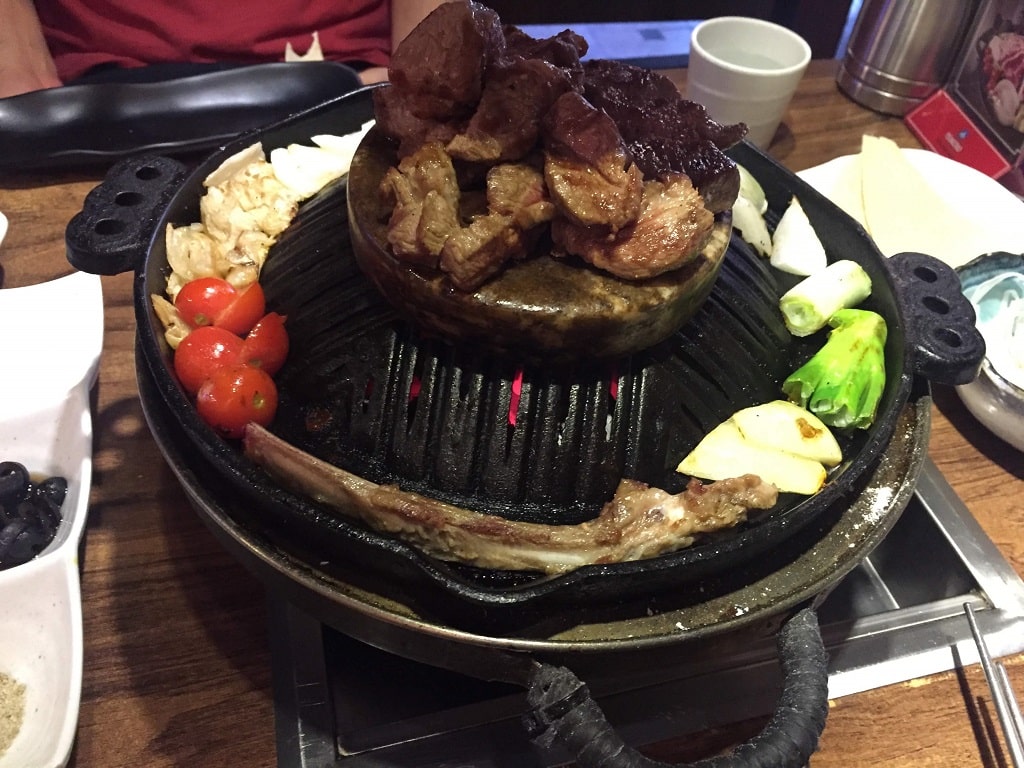
They grill up most types of meat in Korea, so choosing can be a bit daunting. Fortunately, there are two categories that can narrow things down a bit. They are salt and marinade. So you can eliminate half the choices by just deciding whether you want savory or sweet and savory.
If you want both, the correct order to cook and eat them in is saeng gogi (plain) first, followed by yangnyeom (marinated).
From there, you can simply try a few cuts out to see which ones you like best.
Beef
- Galbi (bone in short beef rib)
Galbi comes in two forms, LA galbi which is sliced in thin strips and the original type which is boneless. - Bulgogi (thinly sliced marinated beef)
These are usually cooked before brought to the table. Bulgogi is great in a bibimbap and ssam. It’s cooked in a dukbaegi or stone bowl. - Chadolbagi (brisket)
These thinly sliced pieces are really delicious when they have the right amount of marbling. Chadolbaegi is extra tasty in doenjang jjigae. - Kkot deungshim (rib eye)
The fanciest of KBBQ meats and my personal favorite. - Anshim (tenderloin)
A nice mid-range cut that’s often lean but tender as its name suggests.
Pork
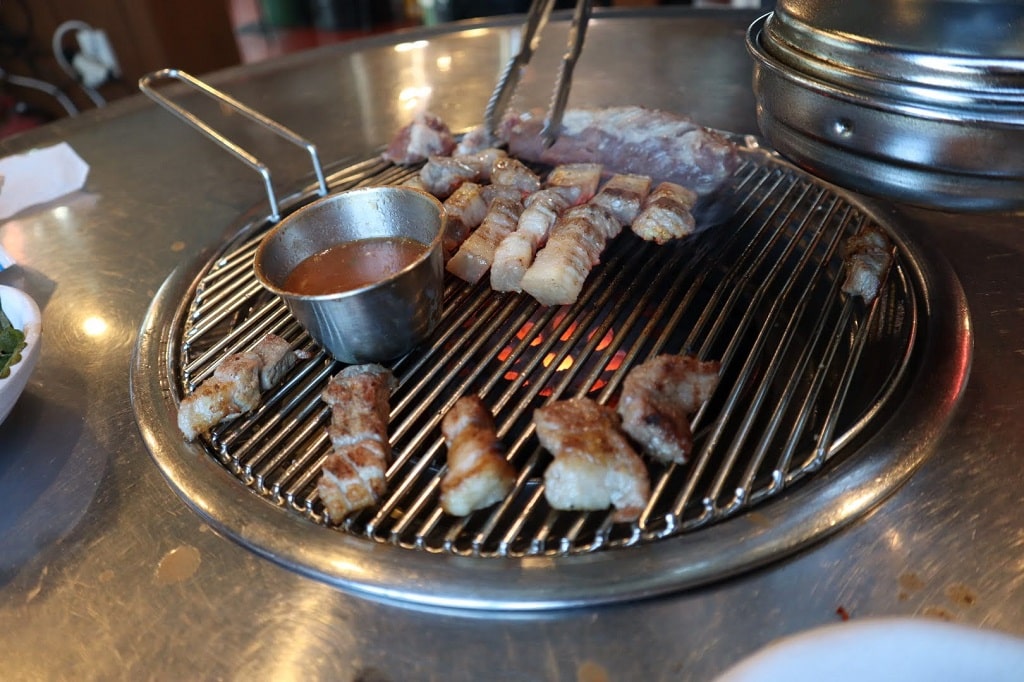
- Samgyeopsal (pork belly)
Imagine grilling thick pieces of unsalted bacon. Delish. This is especially popular in Korea since beef is more expensive. - Moksal (pork neck)
A nice cut because it’s not too fatty like samgyeopsal but still super flavorful. A better choice for camping because there’s less fat to drip on the grill and spray everywhere. - Hangjeongsal (pork back neck)
Pork in a pale pink color with high-quality marbling patterns. Really good stuff! - Galmaegisal (skirt meat)
Although the name sounds like seagull (galmaegi) meat in Korean, it’s the part between the ribs and belly. Galmaegisal tastes so neat and clean without being dry nor greasy. It’s pork, but tastes like beef. Oh yeah! - Heuk dwaeji (black pork): Local Specialty of Jeju Island
Heuk dwaeji bbq is a must when you’re visiting Jeju Island. You dip perfectly barbecued black pork belly in meljeot (멜젓 or salted anchovy) boiling on the same grill. It’s absolutely mouth-watering!
Chicken
- Dak gui
Roasted chicken pieces that are popular in the states. Often called BBQ chicken. - Dak galbi
Marinated in a spicy, sweet and savory sauce that turns into multiple courses. Get the fried rice sprinkled with cheese at the end!
Duck
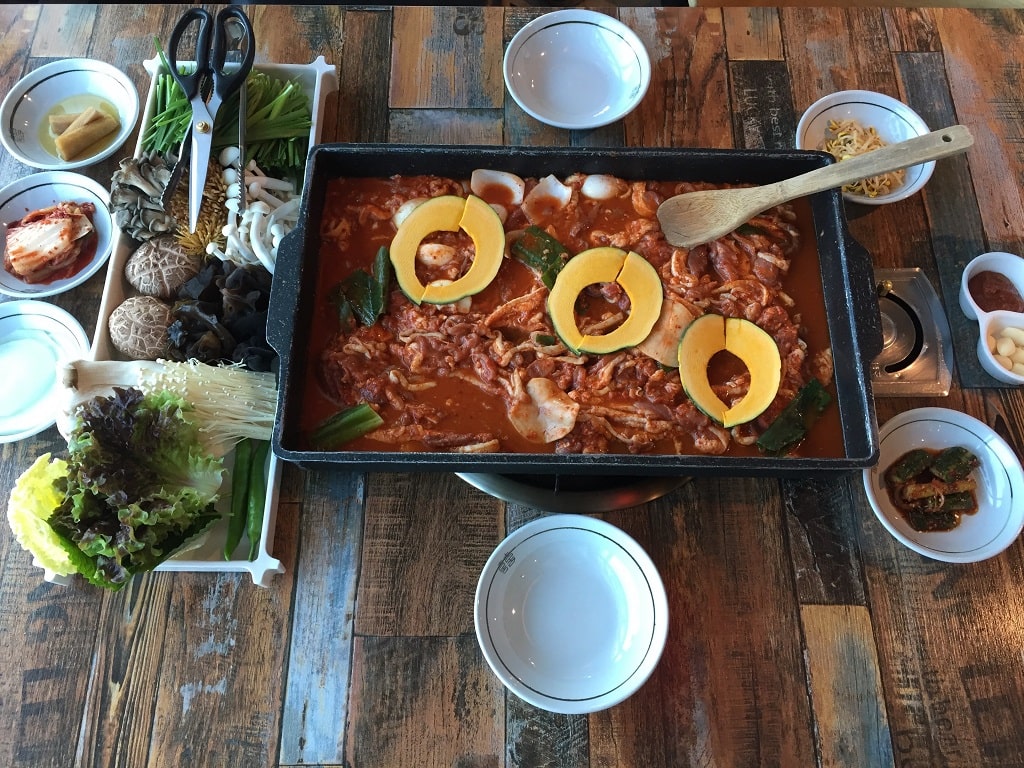
Breast is often used when grilling duck. The most popular types are duck roast (ori roseu) or marinated duck (ori bulgogi or spicy ori jumulleok). They’re perfect with pickled radish slices (ssammoo) and chives (boochoo).
Other cuts
- Naejang (intestines)
Not so desirable in western countries, but super rich and flavorful. Makchang (thick) and gopchang (thin) are big hits in Korea. So fattening, but so good. - Dwaeji kkeopdegi (pork rinds)
The perfect combo of soft, chewy and crispy! It’s very affordable and goes well with soju. Some Koreans used to believe kkeopdegi is rich in collagen, beneficial to skin, but it was just clever marketing. During hweshik, some bosses will say order anything you’d like, but they’ll order kkeopdegi, the cheapest item, to give you noonchi (the most Korean sentence I’ve ever written). Never stopped me from ordering beef though. Some KBBQ owners will give you this as subeesu if you’re a regular.
8. Pair the right booze
They have some pretty strict rules about which adult beverage goes with what in Korea. That being said, you can follow their suggestions or do what you want.
In general, Korean will eat meat with soju and beer. Korean beer tends to be a bit watery so they’ll often combine the two into a boiler maker called somaek.
Chicken is best combined with beer and pork goes well with soju or somaek.
For those who don’t drink, cider or cola will work just fine.
9. Do the garlic right

Koreans literally have a foundation myth based on garlic. It’s that important.
You can always throw the garlic slices directly on the grill, but they tend to get burnt or fall into the flames. The more experienced ask for a maneul jongji (mini stainless steel sauce bowl) so you can heat them up evenly in their own juices. Some places will give you a makeshift foil container instead.
It’s extra delicious when they add chamgireum (toasted sesame oil).
10. Use the leaves
Ssam is the Korean term for wrap. And boy do they have a lot of them. Use them to wrap up the meat, kimchi, ssamjang (mix of doenjang and gochujang), yangpa (sliced onion) and pickled namul (veggies) for a delicious and healthy treat. Here are a few of the more popular ssam types:
- Cheong Sangchu (청상추) – Green Lettuce
- Kkaennip (깻잎) – Perilla or Sesame Leaf
- Samchoo (쌈추) – Korean Cabbage
- Bitamin (비타민) – Dachae (다채) or Tatsoi
- Ssam Kale (쌈케일) – Baby Kale
- Jeok Gyeoja (적겨자) – Red Mustard
- Chikon (치콘) – Endive
- Newgreen (뉴그린) – Toscano
- Cheonggyeongche (청경채) – Bok Choy
For the best results:
- Dip a piece or two of meat in one of the sauces mentioned below
- Put it on a leaf you hold flat in one hand
- Add some garlic (raw or roasted) and ssamjang
- Add some kimchi, onion, green onion salad, ssam moo (sweet radish with mustard) or anything else laying around
- Fold the sides of the leaf over the ingredients
- Put the whole thing in your mouth for a flavor explosion
- Use a LOT of Scope that night
11. Try out the dips
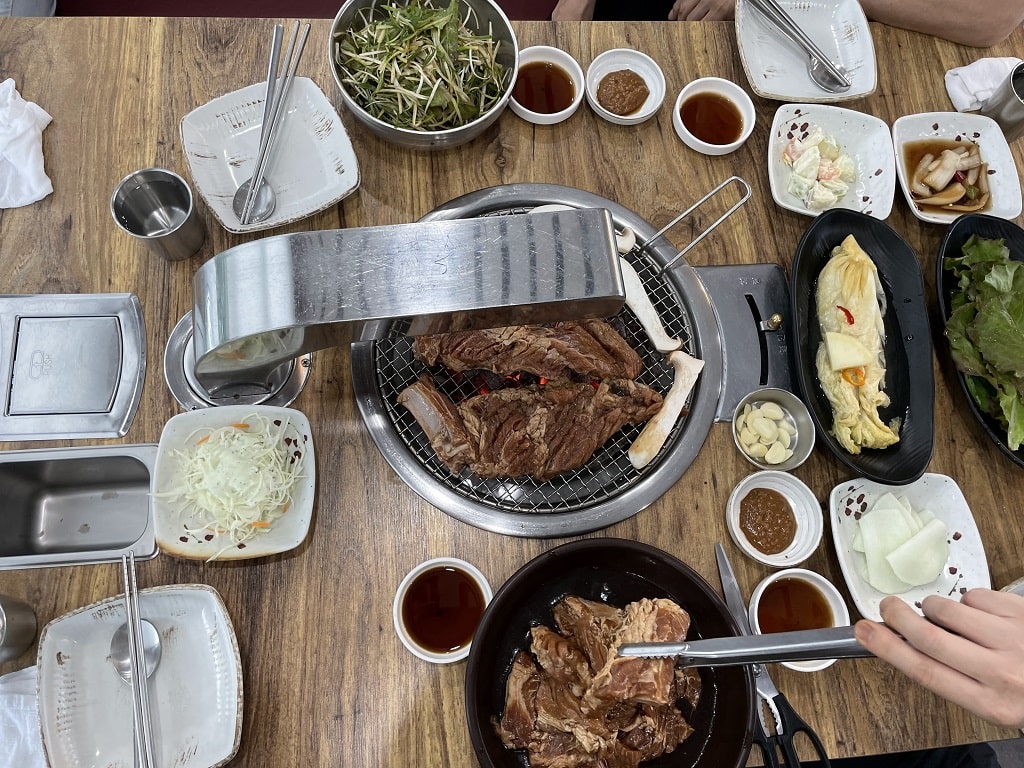
There are tons of dipping sauces you can pair with different meats. Many restaurants create their own signature sauces. The most popular ones are:
- Toasted sesame oil with salt
- Ssamjang
- Mustard
- Light soy sauce with wasabi
- House-made creations
12. Change the grill
If you’re cooking on a mesh or metal grill, it gets charred after a few portions. Ask to change the grill every few cuts so you get clean, flavorful KBBQ all night. This is doubly true if you get the yangnyeom, because the sugar will burn quickly.

13. Get more side dishes
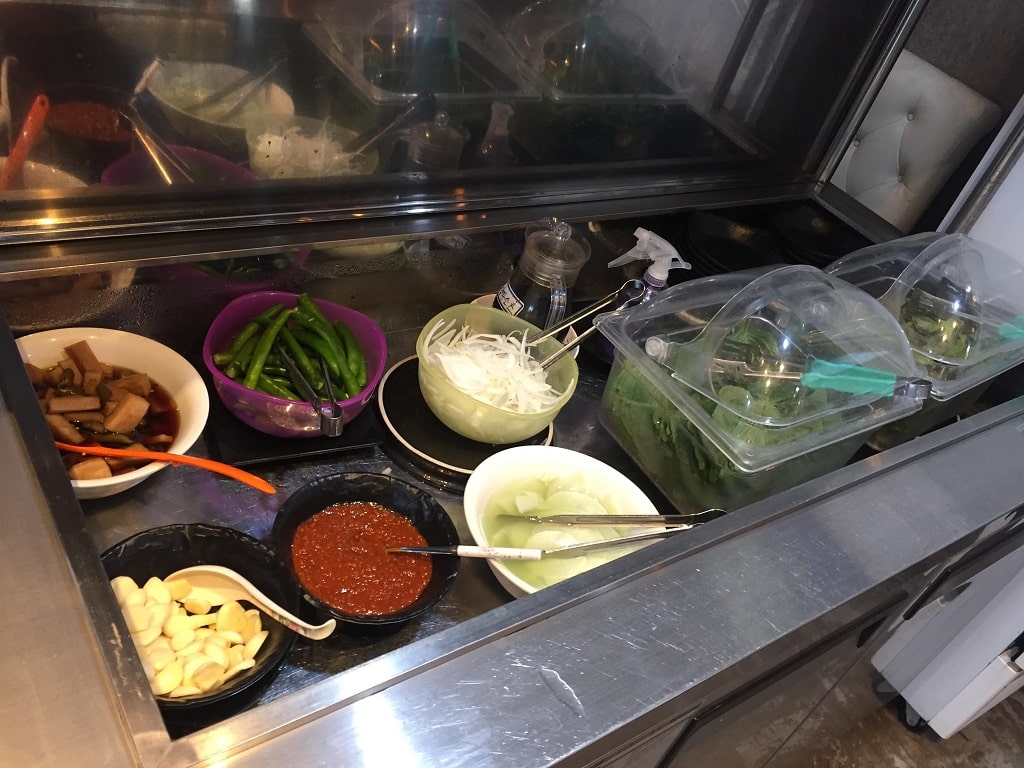
It’s almost mandatory that you ask for at least one refill of those tasty small plates of food. Some places will have a salad bar of sorts where you can grab more kimchi, ssam and banchan yourself.
The best side dishes to combine with the meat are:
- sweet and salty radish slices
- green onion salad (파채무침 or pachaemuchim / 파절이 or pajeori)
- onion slices pickled in soy sauce
- pickled garlic
- pickled kkaennip (sesame leaf)
- pickled siberian onion (명이나물 장아찌 or myeong-i namul jangajji)
Other banchan stand on their own or can be used as a pallet cleanser.
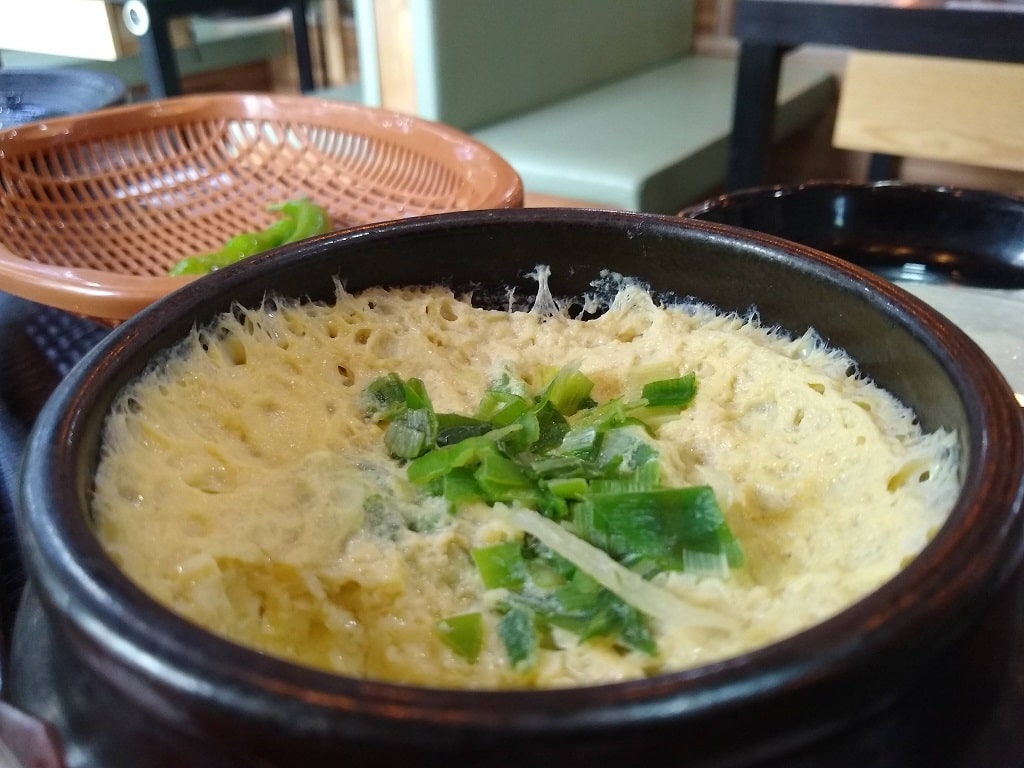
- Gyeran jjim (steamed eggs)
- Gamja jorim (braised potatoes)
- Jeon (savory Korean pancakes)
14. Get the after-party
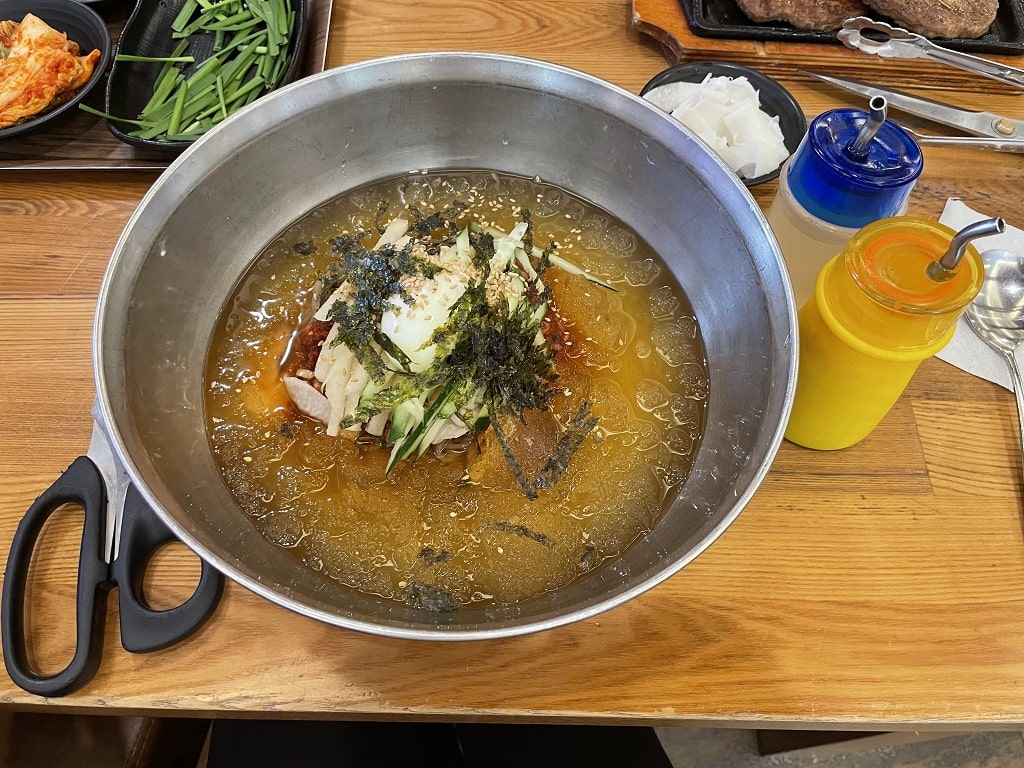
One of my favorite things about Korean food is that they turn one meal into two or three.
After the KBBQ feast is over, you can add rice (bokkeum bap), gim (laver), and other fun stuff to things like dak galbi to turn all those deep flavors into another dish.
Some places have grills with an “egg moat” of sorts for gyeran jjim. Other places add veggies to the moat. These get extra delicious because they soak up the fat from the meat.
After eating all that food, they’ll ask if you want even more food. This is usually something like naengmyeon (cold noodles from North Korea!). You can choose between mool (chilled broth) or bibim (spicy) for naengmyeon.
Another popular choice is doenjang jjigae with rice (soybean paste stew, again, way better than it sounds).
If this sounds like a lot, you’re totally right. But it’s worth the food coma.
15. On the way out
When you leave you might notice coffee machines and an ice cream freezer. Those are fair game so complete the experience with them. I won’t tell. *wink*

What it’s like to eat KBBQ?
It’s a totally immersive experience that offers savory, sweet and sour flavors.
When you sit down, they’ll start bringing out little dishes of food you didn’t order. Don’t panic! It’s all part of the plan and included in the price.
A fire bearer (it’s always an ajeossi in Korea) will bring the heat source and place it in the center of the table while telling you to “watch out”. You must always awkwardly make a show of dodging it by a few feet.
KBBQ includes social bonding aspects since it’s meant to be enjoyed with others (some places won’t even serve you if you come alone). There’s give-and-take during the process with some social hierarchy. The youngest tend to do the grilling while the oldest pays.
When someone (it’s always an ajumma in Korea) comes to change your grill, they’ll snatch the tongs from you and put the meat on the new grill or distribute it evenly if they like you.
You’ll be stuffed with course after course of meat, vegetables and rice while washing it all down with booze. Just when you think you’ve had enough, they’ll offer you more food.
It’s especially satisfying because you take part in the cooking process, but don’t have to clean up!
What else can I do in K-town after eating?
Here are a few ideas:
- Sing noraebang
- Go to a spa
- Get your hair done at a Korean salon
- Play drinking games
- Explore the town
- Learn more about Korea
- Brush up on your hallyu history
- Watch a Korean movie or TV show
- Listen to Korean music
- Get involved in a Korean American Association
Where can I find some good KBBQ restaurants outside of Korea?
Wi Korean BBQ
1101 Vermont Ave #103, Los Angeles, CA 90006, United States
You Grill Korean BBQ
79680 CA-111 #102, La Quinta, CA 92253, United States
Bak Kung Korean B.B.Q
3700 W Olympic Blvd, Los Angeles, CA 90019, United States
Jongro BBQ
22 W 32nd St 2nd floor, New York, NY 10001, United States
Yoon Haeundae Galbi
8 W 36th St., New York, NY 10018, United States
COTE Korean Steakhouse
16 W 22nd St, New York, NY 10010, United States
9292 Korean BBQ
3360 Satellite Blvd #8, Duluth, GA 30096, United States
Mapo Korean BBQ 마포상회
708 Bloor St W, Toronto, ON M6G 1L4, Canada
Kook Korean BBQ Restaurant
2800 E 1st Ave #211A, Vancouver, BC V5M 4N9, Canada
YORI (Piccadilly Circus)
6 Panton St, London SW1Y 4DN, United Kingdom
Arang Restaurant
9 Golden Square, London W1F 9HZ, United Kingdom
Yang San Park
Shop 21/1 Dixon St, Sydney NSW 2000, Australia
Subscribe for
exclusive info on Korea
Did we miss anything?
Let us know your thoughts or questions about KBBQ!



